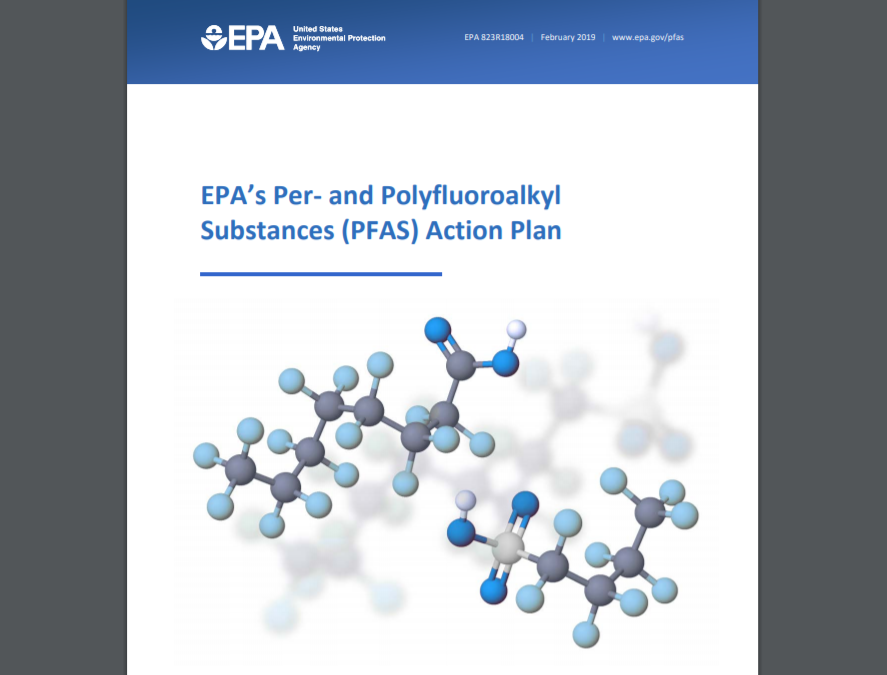
The EPA released its PFAS Action Plan on February 14, 2019.
The United States Environmental Protection Agency (EPA) has released an action plan detailing its proactive approach to identifying per- and polyfluoroalkyl substances (PFAS) to address current, and prevent future, PFAS contamination.
Background
PFAS have been used in a wide variety of industries worldwide since the 1940s. Because their chemical properties make them resistant to heat, water
Click here for more background on PFAS
PFAS Action Plan
The EPA is leading the national effort to understand PFAS, address potential exposure risks and educate the public. The EPA has been collaborating with federal agencies, states, tribes and local municipalities to host community engagement meetings during which the public can express their concerns about PFAS. With the release of its Action Plan, the EPA aims to quell those concerns through a multi-pronged approach that includes the following short-term actions:
- Develop new analytical methods and tools for understanding and managing PFAS risk
- Promulgate Significant New Use Rules (SNURs) that require EPA notification before chemicals are used in new ways that may create human health and ecological concerns
- Use enforcement actions to help manage PFAS risk, where appropriate
These short-term actions are generally already in place or expected to be completed within two years. The EPA’s multi-pronged Action Plan also includes longer-term research efforts and potential regulatory guidance, which are expected to take two years or longer to implement.
Fact Sheet: EPA’s Per- and Polyfluoroalkyl Substances (PFAS) Action Plan
Overarching Challenges
The EPA explains in its Action Plan that identifying the scope of PFAS exposure including sources, pathways, populations exposed and levels of exposure is critical to understanding potential human health and environmental risks. However, there are various challenges associated with addressing PFAS including affordability concerns for PFAS-impacted communities and utilities, a lack of multimedia sampling methods, confusion about health values from various agencies, and information gaps on how to safely handle PFAS-containing byproducts and materials.
Despite these challenges, the EPA has several priority actions to be completed as soon as possible including:
- Develop a national drinking water regulatory determination, commonly referred to as a Maximum Contaminant level
- Complete the regulatory development process for listing PFOA and PFOS as CERCLA hazardous substances
- Develop interim cleanup recommendations to address
ground water contaminated with PFOA and PFOS - Finalize draft toxicity assessments for GenX chemicals and PFBS; develop additional toxicity values for other PFAS compounds
- Use new statutory requirements to review new PFAS and issue supplemental proposed SNURs
Potential Human Health Impacts
Most of the research completed on potential human health risks of PFAS is associated with ingestion of PFAS through use of consumer products, occupational exposure and consumption of contaminated food and water. There is limited data on health effects caused by inhalation or dermal exposure. According to the EPA, most available toxicity research is based on laboratory animal studies. Increased risks observed include developmental effects to fetuses during pregnancy and infants (e.g., low birth weight, altered puberty, skeletal variations), cancer (e.g., testicular, kidney), liver effects (e.g., tissue damage), immune effects (e.g., changes in antibody production and immunity), thyroid effects related to developmental outcomes, and other effects (e.g., cholesterol changes).
Over the past decade, there has been a push toward the use of PFAS classified as less bioaccumulative and therefore less likely to cause adverse health effects in humans and the environment. This includes the replacement of longer chain PFAS, like PFOA and PFOS, with shorter chain PFAS. According to the EPA, long-chain PFAS are believed to present greater toxicity to human than short-chain PFAS, though toxicity levels of short-chain PFAS have been significantly less studied

